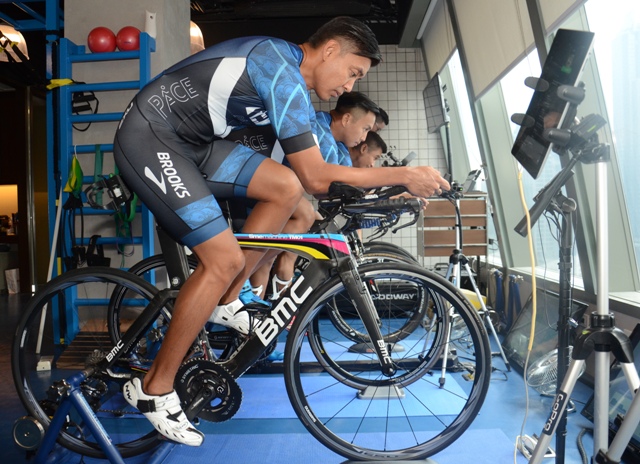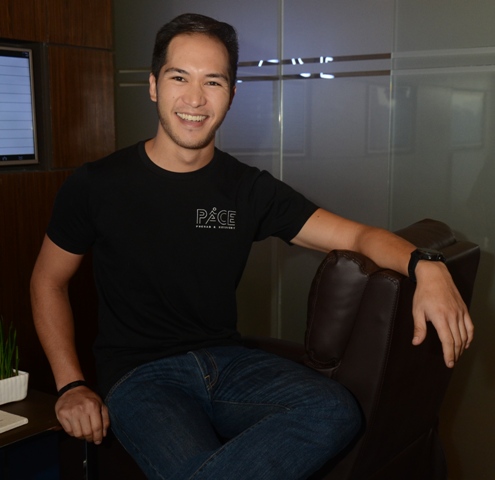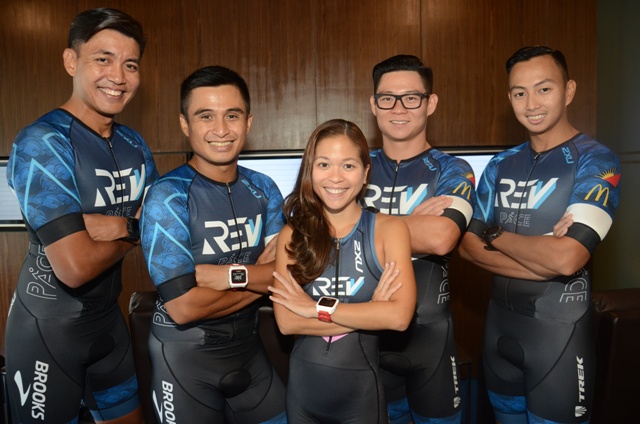
Triathlon is not as simple as swimming, biking and running—at least not for the people at Pace Prehab & Recovery.
It’s a science that governs how our bodies move, and how energy is stored and expelled, and the application of this science is what sets this team apart from the rest of the racers.
Its facility has the latest technology on measuring power and gait, and checking and correcting any imbalance one may have during running or cycling.
These weaknesses will be corrected in real time—they learn to run and bike in their best form, so come race day, these corrected forms will become second nature to them.
It also means racing at one’s most comfortable zone. When this happens, there’s lesser or zero injuries, even for a very demanding sport like triathlon.
(See related story: Now you can spot that knee injury before it happens)
Revv, the tri team of Pace Prehab and Recovery, will race in its first Ironman 70.3 Philippines as a team on Aug. 7. All members are confident that as long as conditions are right, they will cross the finish line with zero injuries.
Francis Diano, managing director, said they take into consideration the nutrition and the number of hours of sleep their athletes get. He is an orthopedic board-certified specialist, sports board-certified specialist, certified orthopedic manual therapist, and certified strength and conditioning specialist.
“It’s the same as going to the gas station,” Diano said. “You have the equal saver, high-octane, low-octane… You can fill it up with 30 liters, but which one will make your car perform best?”
Shy Sison-Vesagas, one of the cofounders of Pace, said she was a vegetarian for 22 years until last year, when she joined her first triathlon. “I have to start eating meat so that the calories stay in my body and I can last the entire race.”
Red blood cells
While plant protein is good, said Diano, it doesn’t give the athletes the performance they require to finish the race.
“Red meat is important so that her body could produce red blood cells to perform the activities, because the endurance sport that we’re in is very reliant on the transfer of oxygen to the different systems of the body,” Diamo said.

it will learn to efficiently consume calories and expel them.”
“If you don’t have enough red blood cells, you won’t have enough medium to transfer that oxygen, as well,” he added.
And that’s why you see many athletes cross the finish line gasping for air, or nearly unable to walk.
At Pace, the athletes learn the discipline that enables them to cross the finish line as comfortable as they can be.
“By comfortable I mean I don’t catch my breath,” said Sison-Vesagas. “I don’t feel like my knees are falling apart, or my hips are about to give. I used to do marathons, but after the 21-kilometer mark I would always feel like my hips were giving way. Now, with Francis’ program, when I cross the finish line during triathlons, I can walk properly. I don’t walk like a duck anymore.”
Sison-Vesagas finished her first triathlon late last year, just before she turned 40. She learned to ride a bike just three months before race day.
“Every tweak I’ve done in my program is not just based on Francis’ hunch or my hunch. The computer tells me I’m supposed to push harder on the right side, or I’m not on the ground too long when I’m running, or that I have to lift my leg higher,” she said.
Al Gonzales, head coach of Streamline Sports Instruction and Revv member, said they can even download the profile of a particular race course, plug it into the computer, and hop on the bike on a route simulating the race course—uphills, downhills and all.
“So, more or less I can race on that course indoors and have an idea how it feels for me to race that course later on. You’ll feel the resistance, including the steep inclines. I can’t do a 180-km bike outside, for example, without any distractions, like cars and buses, encountered along the way,” Gonzales said.

This is helpful when racing abroad, when the terrain is unfamiliar to him. The technology used by Pace is so precise, Gonzales said, in terms of what zone you want your body to be in.
There are also built-in programs in the computer that you can train on when you’re not preparing for a race.
Recovery is part of training
It also teaches you that going all out all the time will not make you stronger. Another big difference at Pace is that recovery is part of the training.
“Many people take that for granted,” Gonzales said.
Diano agreed: “As you’re burning the fuel, you wear down parts of your body. It starts to fatigue and break down parts of your muscles, and wears and tears the joints, as well. The only time the body fixes itself is when you’re sleeping. If you don’t get at least seven hours of sleep, your body won’t be able to recuperate for the next effort.”
Pace, barely six months old, already has a strong following, not only among athletes but also among people from all walks of life—the seniors, the sedentary, and even young kids.
“It’s amazing how this is shaping up to be, but all those are also under Francis’ specialty,” said Iah Isip, one of the cofounders of Pace.
He said he met Diano in New York, when he was injured and wasn’t sure if he could join the race. An athlete tipped him off about this good Filipino therapist, so he went to see Diano and had him take a look at his foot.
In a month, he was able to join the New York marathon and raced a triathlon in the same month. It was then that he thought of opening Pace, and bringing Diano to Manila.
“Injuries are hard to avoid,” Isip said. “With the load of what we’re doing, it’s inevitable. But because of Pace I already have a parameter within which I can work out. I know how far I can push my body. It’s like I have a guideline, unlike before when I just push, push and push.”
Gadric Chusenfu, triathlete and VP of New Wealth Properties Corp., said Diano asked him to decrease his training mileage and run a little less and slower. With his running and biking form corrected, he now races faster and, as Sison-Vesagas said, more comfortably.
Pace Prehab & Recovery, 16/F MDI Corporate Center, 10th Avenue corner 39th St., Bonifacio Global City. Call 0915-6783600 and 9463054; visit their website here.












































